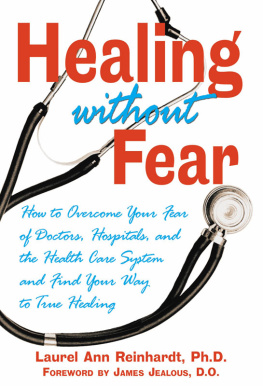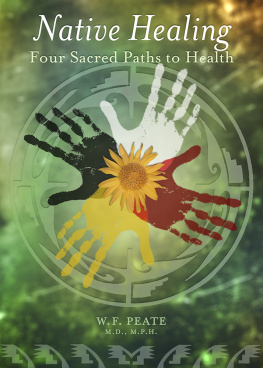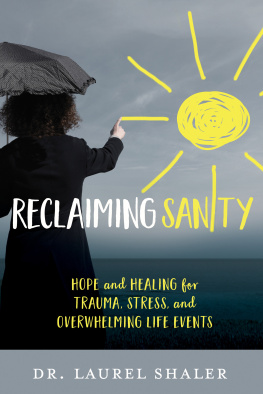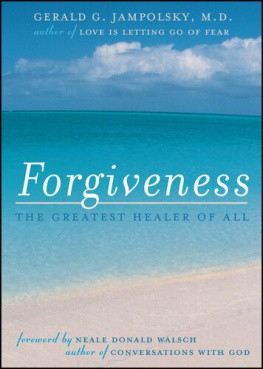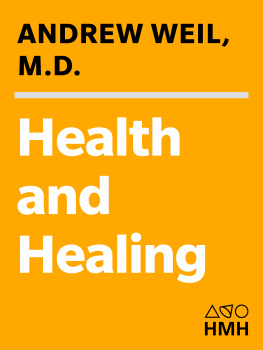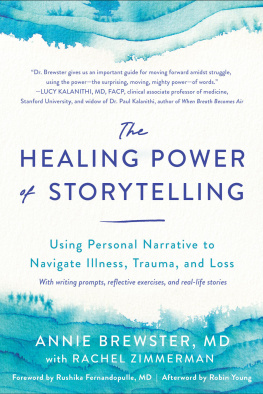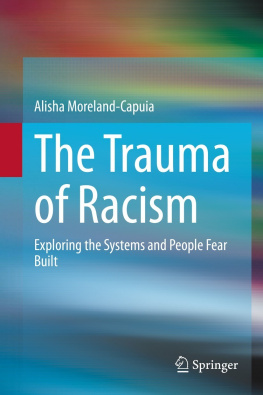HEALING
WITHOUT
FEAR

Laurel Ann Reinhardt, Ph.D.

Healing Arts Press
Rochester, Vermont
Acknowledgments
I want to express my gratitude to the following people, without whose help this book would never have been written or published:
All of the friends and healers who loved and truly supported me by allowing me to find my own way through two health care crises; a special thank you to Ellen.
All of the people who allowed me to interview them, whether or not their stories appear in this book; they are both courageous and inspiring.
All of my friends and colleagues who kept encouraging me to continue with this book, even through the most difficult of times; a special thank you to Claire.
All of the people at Healing Arts Press who believed in and helped bring this book to publication, looking and reading even better than I had imagined it.
Contents
Foreword
Fear is something we all experience, but individual relationships with fear vary considerably. As a general practitioner of osteopathy for more than twenty-five years, I have had intimate conversations with thousands of unique individuals about their fear and their relationship to it. Fear can vary in nature from an acute emergent terror to a chronic subliminal and almost imperceptible fear that is so much a part of the individual that it remains constant and unnoticed. Under natural conditions fear comes and goes along with lifes surprises. When fear becomes steady and unyielding, successful resolution is proportionate to the health of our perceptual integrity and stability.
I practice among the rural natives of Maine, and I observe them living on the land, where they are deeply aware of the seasons, of changing weather, and of the inconvenience of natural events. When we live in rhythm with nature and her moods, a natural perceptual balance between ourselves and something greater is constantly nurtured. When our attention is focused not only on the event at hand but also on the background, a certain balance is maintained that allows us to observe our fear in a broader context. This perceptual integrity is an essential feature of how we respond to, integrate, and understand fear and its true meaning.
Animals in the wild have this perceptual integrity. They are, like my rural neighbors, alert and uniquely balanced individuals. When sensing danger these wonderful creatures become still, heighten their senses, wait, and collect the moment in its wholeness, and then act instinctively toward a sense of continuum and wisdom. Waiting is a key element in responding to the unexpected. In the case of human illness, fear can run wild and we may make irrational decisions by being overly rational about the situation. Waiting and allowing intuition and instinct to contribute to our response often yields an unexpected ease of action. We become allies to ourselves, embraced by the calming tempo of patience.
Fear brings us knowledge. If we squirm away from it our senses will collapse and fail. If we wait we find that fear brings us to a deeper trust, delivering us from the grip of rational ambivalence with its frightening need to be immediately comfortable and subdued by denial.
My personal experience with both friends and patients has taught me that the root of fear is a separation from the Wholeness of Love. Fear arises when we lose our sense of the Divine Background, when we shrink our perceptual field to the point where we are alone, coldly isolated from the wider peripheral sense of natures rhythms and the divine warmth of Oneness. Fear in all its varieties reminds us that something is missing, and eventually we come to a point of memory that speaks to us so deeply that a softness pervades the sharpness of fear and we sense the healing light of a widening vista and the divine embrace of freedom.
Fear is the friend ringing the doorbell of our being, hoping for someone to answer. Our task is to hear this call and wait with a wider vision until a natural balance emerges from the instinctual core of our being. This is not faithit is an instinctual knowing of ones origin in the womb of life, and it produces an awareness that carries us into calm.
J AMES J EALOUS , D.O.
E ASTON , N.H.
Introduction
A few years ago I had the opportunity to experience all the aspects of fear that Dr. Jealous describes in the Forewordas well as an additional aspect. One morning in December 1996, I found, as have millions of women and men before and since, a lump in my breast. Even as I poked and prodded, hoping that my untrained fingers would discover they had been mistaken, my mind had already leapt to the assumption that the lump was cancer and that something needed to be doneimmediately. I quickly entered what I now think of as the field of fear, which I believe pervades health care in the United States and which dogged me at every turn for the next several days, weeks, and months. Though at first I believed it to be entirely my own fear, I gradually realized that it was, in fact, a field of fear, an entity that fed not just on my fears but on those of others as well.
Be preparedTo risk everything youHold preciousFor the truth inside you.TRUTH is EmpoweringAnd to speak the truthIs to overcome the fearof death.
J ANE E VERSHED , T RUTH V ISITING
M Y P ERSONAL S TORY
I have spent the last two decades using what are generally considered to be alternative or complementary types of health care, including osteopathy, chiropractic, homeopathy, and Asian medicine (for example, acupuncture, herbs, and Qigong). I now realize that I discontinued my use of Western medicine precisely because of the field of fear that surrounds it, though I didnt define it that way at the time. This is not to say that alternative health care doesnt contribute its own set of fears to the field of fear, but in my experience the field is much less palpable in alternative health care.
In the early 1980s I struggled with pneumonia every fall for three years. After the last bout I ended up developing what my doctor referred to as a type of asthma that was primarily exercise-induced. I was given an inhalant (which I later found was rumored to be carcinogenic) and was urged to use it prophylacticallythat is, before exercising. I was also told that there was nothing else to be done. Unwilling to live the rest of my life that wayI was barely in my thirties and wanted to continue enjoying such activities as tennis and skiingI elected to get a second opinion from a homeopath. The remedy he gave me immediately eased my symptoms, and I never looked back.
I didnt look back, that is, until I found the lump in my breast and once again felt the fear rising up within me. Perhaps it was this fear and its association with Western medicine that sent me running back to a Western medical doctor. Although I didnt have a personal physician, I thought I knew of one who would be able to see me for who I was and work with me in ways that would feel comfortable for and respectful to both of us. What I hadnt considered was the field of fear, within which the doctor practiced her art and which limited her as much as it threatened me.
Within a few minutes of entering the doctors office I felt as if I had been dropped onto a bobsled that was heading straight down a mountain. The first indication was in the waiting room, where I began to feel a vague disquiet. As I was shown to a treatment room, I mentioned to the nurse that I was hoping to have a Pap smear as well as a breast exam. She checked my chart and informed me in a brusque, hurried, fearful manner, that I had been scheduled for two time units rather than the three that were required for a Pap smear. I felt my disquiet turn into apprehension; what if I couldnt get all my questions answered in the two allotted time units?
Next page
